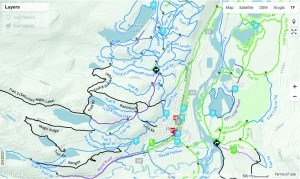
In an era of smart phones, mobile apps and big data it appears Parks Canada still has a lot to learn.
News this week that Parks Canada asked the Jasper Park Cycling Association (JPCA) to temporarily remove data from a mobile app highlights the agency’s outdated policies and archaic attitude towards new technologies.
In late spring Parks Canada asked the JPCA to remove more than a dozen wild land trails from Trailforks, a mobile app popular with the mountain biking community.
Three months later the trails mysterious reappeared without any explanation.
The trails in question are officially part of Jasper’s Three Valley Confluence (TVC) Trail Plan, however Parks Canada does not publicly promote them on any of its maps and presumably would have rather kept them a secret.
Here’s the problem.
Mobile apps are not the purview of Parks Canada, or any level of government for that matter.
The fact that Parks Canada even had the audacity to ask an organization to remove public information from a mobile app is disturbing.
Just imagine if Parks Canada tried to stop people from sharing information on Facebook or Twitter—the public backlash would be immediate.
Yet somehow Parks Canada was able to convince the JPCA that it was in everyone’s interest to temporarily hide information about Jasper’s wild land trail system for the majority of the summer.
At the risk of connecting dots that don’t exist, it isn’t much of a stretch to imagine why the cycling association might have played along with Park’s bizarre request, given that the non-profit group was in the midst of trying to convince Parks Canada to set aside a piece of land for a mountain bike park.
Whatever the reason, the real issue here is that Parks Canada over-stepped its authority by trying to control public information on a platform that it has no jurisdiction over.
By trying to limit public information Parks Canada was also limiting Canadians freedom of expression, a fundamental human right under the Canadian Charter of Rights and Freedoms.
Fortunately cooler heads prevailed and Parks Canada recognized its error.
Let’s hope the next time someone uses their creative ingenuity for the public good Parks Canada embraces the technology instead of fighting it.
